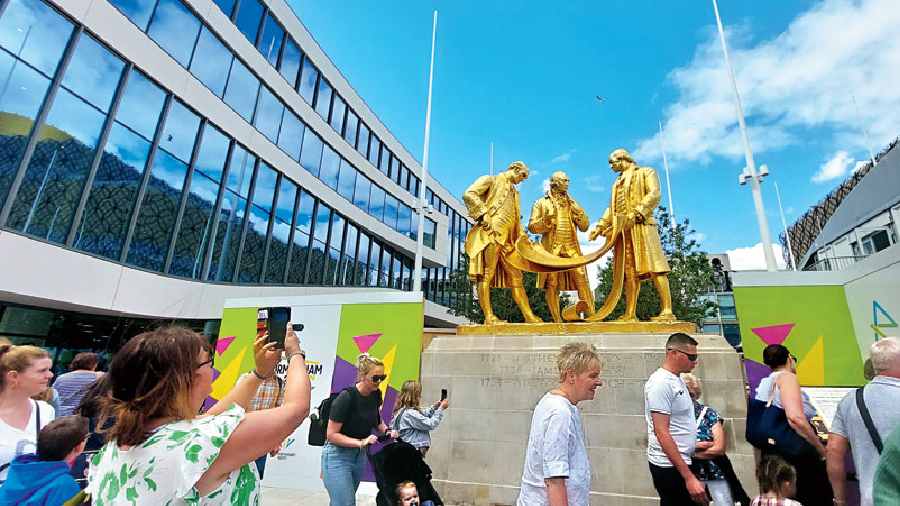Shakespeare’s backyard, home of Balti cuisine, manufacturing hub since the Industrial Revolution… many identities sit well on Birmingham, the United Kingdom’s second city.
A trip to England completely bypassing London sounds unimaginable. But once one is ready to accept that, it opens one’s eyes to the possibilities of the other regions in the UK, like the West Midlands in our case. With just three free days in hand after finishing work, we hit Brum running.
CITY LIGHTS
Birmingham’s most touristy hangout is Celebration Square, home to many of the city’s significant buildings — Baskerville House, the Library of Birmingham, Birmingham Repertory Theatre and the ICC & Symphony Hall, fronted by a reflective pool where children love to get drenched in summer, which is the season when we had landed. And yes, our favourite eatery Dishoom, serving Bombay street food and more, is also next door.
We were shown around by Jonathan Berg, the author of Positively Birmingham who also undertakes walking tours. “In an oak-paneled room at the top is the world’s largest collection of Shakespeare plays,” he said, pointing to the top of the library, as we waited for our group members to congregate. Since Stratford-upon-Avon, though within an hour’s drive, was sadly not on our itinerary, this was the closest I was to come to the Bard on this trip.
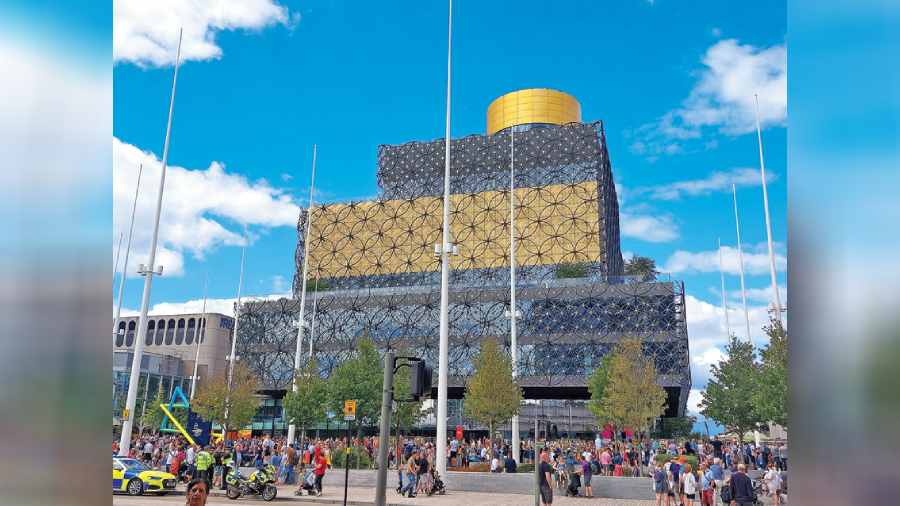
The Library of Birmingham has in its collection in the top room the world’s largest collection of William Shakespeare’s play
The tour started at the feet of The Golden Boys — gilded bronze statues of Birmingham’s three most illustrious harbingers of the Industrial Revolution, of which the area became a cradle. Matthew Boulton had set up the world’s first large-scale factory. James Watt had invented a more efficient steam engine design and joined Boulton to mass produce it globally. The third figure, William Murdoch, was sent by Boulton and Watt to install steam engines in Cornwall.
Berg gave an account of how the city thrived in Victorian times, bringing in coal supplies along the Birmingham canal which was built for the purpose.
Once a Birmingham doctor, John Wright, discovered a simple way of electroplating, the process was applied to costume jewellery by the Elkington cousins and the city’s jewellery quarter boomed, as did the automobile sector after World War II.
War history is very much present on the square in the form of the Hall of Memory, which commemorates the fallen in both World Wars and later campaigns.
The adjoining Victoria Square has the Birmingham Town Hall overlooking it and is a concert venue. What caught the eye was the sculpture of an unclothed woman as the centrepiece of a fountain. The artiste is an Indian, Dhruva Mistry, Berg announced enthusiastically. “The name of the piece is The River. We call it ‘The Floozie in the Jacuzzi’,” he added, with a wink.
Another highlight of the walk was witnessing the stained glass windows at St. Philip’s Cathedral. Edward Burne-Jones, the preRaphaelite artist, was born nearby and the four windows here, including The Last Judgment, are among his finest work. “The city was badly bombed during World War II. The windows were packed to be removed for safekeeping to a mine in Wales. That very night there was a bombing raid but the windows survived,” Berg said. Providence!
TEA TIME
The sonorous clinking of spoon against bone china, laughter and conversation flowing in measured tones, warm scones and sandwich triangles on the plate and bright sunlight bathing a tearoom of enchanting beauty and elegance.
There are places in England where social customs are celebrated as a tradition. The World of Wedgwood, with its servings of breakfast, brunch and afternoon tea, is one such quintessentially British address in Stoke-on-Trent in Staffordshire. Nestled amid an award-winning garden, it is an experience wrought in finely crafted bone china teaware that epitomises new-age luxury.
You can have tea here as also take the celebrated crockery home as the front half of the tearoom is a showroom. Outside the sitting area, tables are laid out with exquisite tea sets, as if ready to seat guests. The only clue of this area being a shop is the presence of a card on each table that lists out the name of the collection, the pieces of cutlery included in the set and the price — enough to drill a sinkhole in even moderately deep pockets. There has to be a price to pay for crockery used in premier households like the Vatican, the Kremlin and the White House...
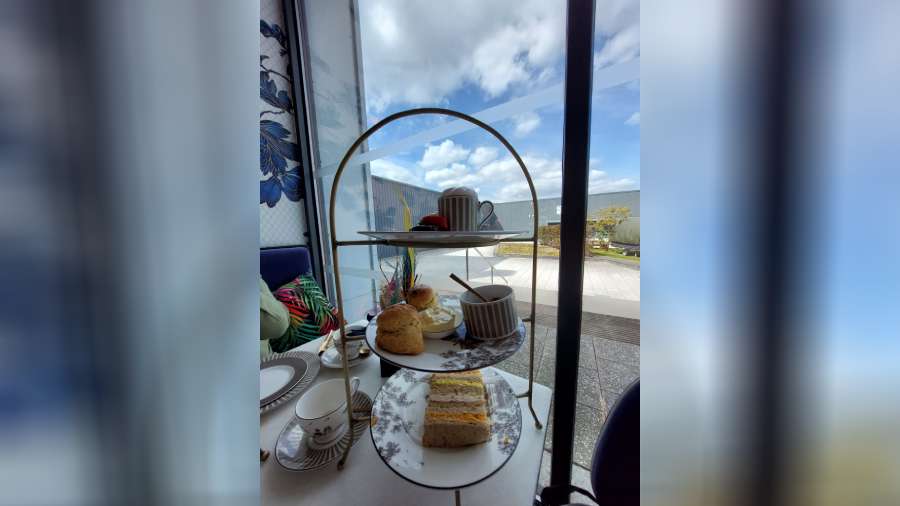
A three-tiered cake stand at the World of Wedgwood Tea Room
Wedgwood’s association with British royalty began with Queen Charlotte, wife of King George III, who ordered a cream-coloured earthenware set. So impressed was she that Josiah Wedgwood was given the permission to call himself ‘Potter to Her Majesty’. He was canny enough to rename the creamware set Queen’s Ware.
Bookings at the Wedgwood Tea Room are tough to get. But our hosts from VisitBritain had arranged for us to be treated to the iconic afternoon tea. Sandwiches, scones, meringues and cupcakes arrived in a three-tier cake stand accompanied by unlimited loose leaf tea in signature cutlery.
After a fine meal, we went on the Wedgwood collection guided tour to be shown archived examples of Josiah’s innovations, the finest of which were nothing short of poetry in crockery.
Jasperware, Josiah’s best-known invention, was put out in 1774 after thousands of experiments, the stages of which were explained to us. The unglazed stoneware in chalky biscuit-like texture was produced in blue, green, lilac, yellow, black and white, sometimes with a few colours combined in one piece. But it is the iconic light blue version of Jasperware that gave birth to the term Wedgwood Blue.

(Top) Wedgwood pottery in white Jasper, green and blue dip. (Above) A tablet depicting birth of Bacchus
To this day, the Jasperware recipe remains top secret and all that we were told is that the colour comes from staining the clay with mineral oxides.
On the way out, showing a portrait on the wall, our guide mentioned: “(Theory of evolution proponent) Charles Darwin’s mother was a Wedgwood.”
Our last stop at the place was a do-it-yourself turn at the potter’s wheel inside The Children’s Studio. The trainer showed us how to take a lump of sticky clay and hold it against the running wheel, working the pressure on the fingers to give it a shape. After a few attempts, most of us realised that Wedgwood perfection was not for us and we would be happy to create some shape. Any shape!
WILLY WONKA, ANYONE?
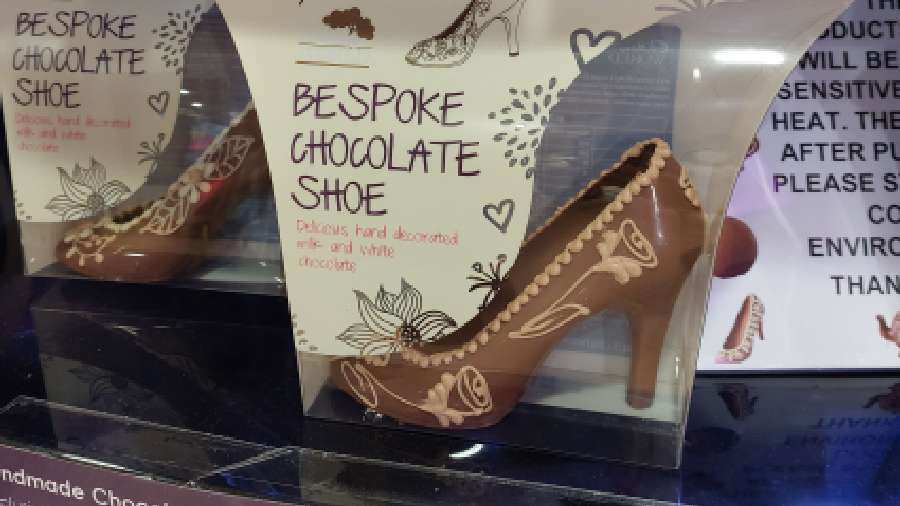
A bespoke chocolate shoe at the Cadbury World shop, priced £9.95
The destination that had us cartwheeling back to our childhood was Cadbury World, about 8km from the Birmingham city centre.
The business might be owned by Mondelez International now and the manufacturing taking place elsewhere, but this is the original Cadbury’s factory site on which has come up an experience centre which shows how chocolate is made, shares the history and, most excitingly, lets you play with chocolate.
Circa 1830s, chocolate was available as a drink and affordable only for the rich. John Cadbury, the founder, solidified it in bars so that everyone could have it cheap.
Bournville, the dark chocolate brand, is named after the village where the brothers, Richard and George Cadbury, decided to shift their expanding business to from the city of Birmingham in 1878. It had a trout stream flowing by called the Bourn. “Anything French was considered fashionable at the time, so they added ville to the river’s name,” said the genial guide with greying locks who was showing us around. She had been working here since the age of 16 and her parents had worked here too.
Indeed, workers at Cadbury’s manufacturing unit could stay close by at the staff quarters amid gardens and take part in recreational activities, conditions unheard of in Victorian times when factories were synonymous with squalor.
The founders were from the Quaker community, which did not smoke or drink. “So there is no fast food restaurant or pub in the area,” said the guide. “But while we are working, the chocolate is free,” she added with a smile.
Over the next three hours, we were greeted by a giant duck, heard the company’s century-old history narrated by a speaking head which appeared over the screen showing the film, walked through a corridor flanked by pictures in chronological order of the bars that the company has rolled out, rode in a vintage electric car along a track in a tunnel where cocoa beans as three-dimensional characters peopled the scenes, unfolding on both sides of the car, on their journey from pods to wrapper.
Then came the fun part. We were handed piping bags filled with molten chocolate and asked to write or sketch on a marble table top. There was a photo booth where one could pose against the blue screen after choosing a Dairy Milk bar from an options list which would be added digitally and printed as a souvenir photograph. Since the bar I chose was doubling as a surfing board in an ocean of molten chocolate, I was asked to pose standing with a slight crouch with hands spread, as if in the act of balancing on the imaginary board.
How can one step out of a chocolate factory without tasting some? Though three bars came complimentary with the ticket, there was promise of more at the final counter where visitors were invited to temper chocolate, a stage dealing with the semi-molten stuff that comes out of a machine at 50°C before they are put in a mould. On following the instructions came the prize — a cup of molten chocolate with one’s choice of inclusions from a list of lip-smacking choices including fudge, jelly babies, mini mallows and giant Bournville buttons.
The tour ended in the world’s biggest Cadbury store. It was like Charlie Bucket, the young boy in Roald Dahl’s novel Charlie and the Chocolate Factory, stepping into Willy Wonka’s chocolate kingdom.
Chocolates were everywhere, in every size and sometimes in shapes that you did not know they made chocolates in. A bespoke chocolate shoe, a decorative chocolate teapot and a football, ranging in price from £9.95 to £19.95, startled and tempted one from the racks.
The only non-chocolate items on sale were branded T-shirts, pens and erasers. Consolation souvenirs for diabetics!
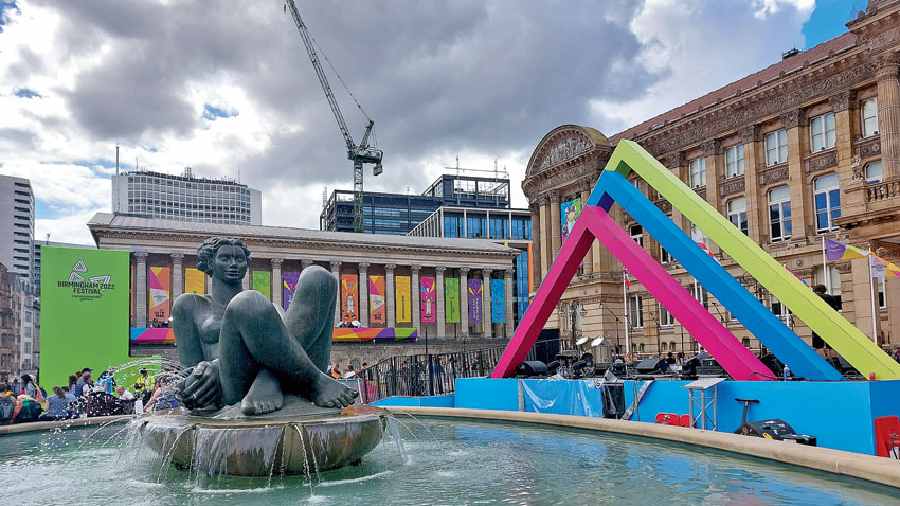
The River at Victoria Square by Indian sculptor Dhruva Mistry, loosely called ‘The Floozie in the Jacuzzi’ by local people
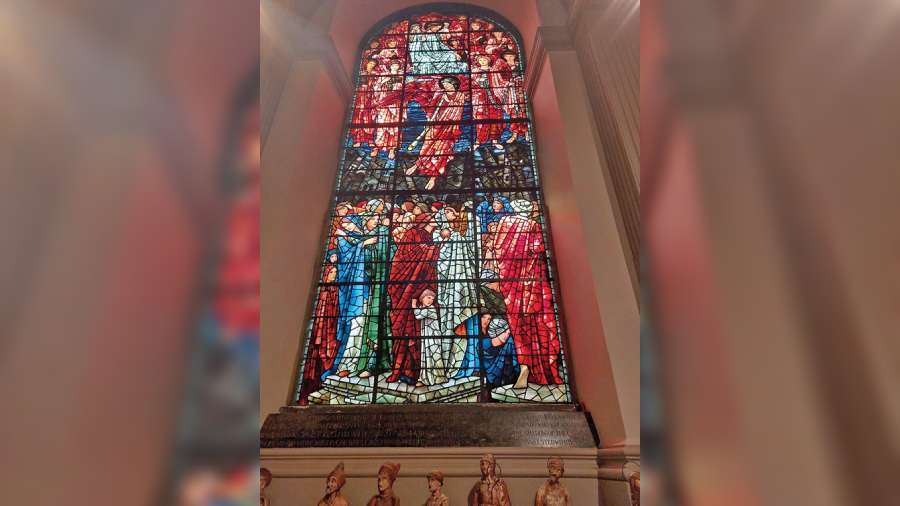
The Last Judgment, a stained glass pre-Raphaelite classic, by Edward Burne-Jones at St. Philip’s Cathedral
TASTE OF BIRMINGHAM
Yes, we did taste curry. That was at a little Bangladeshi eatery near our hotel. But to my palate, it was a bit too spicy. Of course, the bill was a fragment of that at Dishoom. But give us Nalli Korma, Chole Puri or Prawn Koliwada at Dishoom any day! The décor too was strikingly sepia-tainted, taking one back to post-Independence Bombay.
Our other big eat-out experience was Asha’s, the diva’s signature eatery. Photographs dotted the wall of Asha Bhosle with illustrious colleagues as well as of celebrity diners.
Tom Cruise came here in August 2021 and ordered a repeat of Chicken Tikka Masala. The story was shared by the restaurant manager Jebin Jacob. “Since then, people come and ask for the ‘Tom Chicken’,” he said. Other famous guests to have visited include Ed Sheeran and Rolling Stones, as also several Indian cricketers.
“When Ashaji comes, she spends all her time in the kitchen with the chef. She is very passionate about taste. There are four dishes in our menu for which she has given the recipe — Chicken Kheema, Muscat Gosht, Chandni Chowk ka Kheema and Hare Baingan Ka Bartha. These dishes are there at every branch of ours,” he said. What does she order herself? Daal and Baingan Ka Bartha, he responded.
SHOP TILL YOU DROP
On the way back to the Heathrow airport, we stopped midway at Bicester Village.
The pleasing sights here are not lush meadows but discounts on branded clothes and accessories. About 160 of the world’s top luxury fashion and lifestyle boutiques have found space on this 1.2km strip which has all-day dining facilities. For the privilege club member, there is an apartment to rest in and a personal shopping assistant to let one shop hands-free. For them, of course, the drinks and food are on the house.
No wonder, celebrities love to pick up their designer partywear from here, away from public eye and at a discount. “I remember visits from Kajol and Ajay Devgn, Shilpa Shetty and Swara Bhasker. Sachin Tendulkar also comes a lot,” said the Village official, who dropped by to meet us. “We are the second most-visited attraction of the UK after Buckingham Palace. Our 2019 footfall was seven million,” she claimed.
Statutory warning: Keep this visit as the last stop before leaving the country as all the pound notes tend to take leave of the wallet, both physical and digital.
“You can spend a week in Birmingham and not see everything there is to see.” Councillor Ian Ward, leader of Birmingham City Council, tells The Telegraph why he thinks so
We have a lot to offer. The problem is we have not shouted loudly enough about the tourist attractions that we have. We have more canals than Venice and more trees than Paris. We have the most Michelin-starred restaurants in the UK outside of London. We have the largest public park outside of London. That’s Sutton Park in the north of the city, a former royal park used by King Henry VIII for hunting deer.
We are among the top five of city tourism destinations within the United Kingdom.We have the largest collection of preRaphaelite art anywhere in Europe in our museum.We are the cradle of the Industrial Revolution. Matthew Boulton built the first-ever modern manufacturing facility here. Boulton’s partner James Watt, when he lived in Aston Hall in Birmingham, made refinements on the steam engine.When the two were manufacturing steam engines in Birmingham and exporting them around the world, Boulton had said:“What we manufacture here is what the world desires — power.”
Stratford-upon-Avon, Shakespeare’s birthplace, is literally down the road. We have the Shakespeare Memorial Library which anyone can visit, thanks to George Dawson, who believed Shakespeare’s works should be freely available to everyone. One of the First Folios of the works of Shakespeare is in the library.
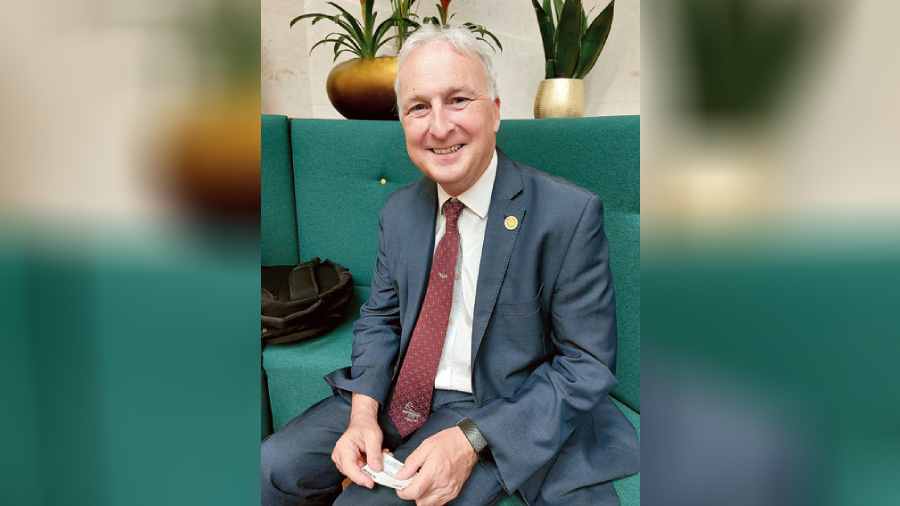
Ian Ward
We have the Cadbury chocolate factory. The jewellery quarter within Birmingham produces 40 per cent of the hand-made jewellery in the UK. You can visit the wholesale jewellery makers and purchase at wholesale prices. We have the museum of the jewellery quarter where you can get an understanding of the history of jewellery-making.
We also have a pen nib museum. In the early 19th century, 98 per cent of the pen nibs of the world were manufactured here. So you could say the most important documents around the world were signed by pen nibs made in Birmingham.
We also have Warwick Castle that played an instrumental role in the War of the Roses. There’s also Kenilworth Castle that is one of the most beautiful castle ruins in England. Queen Elizabeth I stayed there during her reign.
We have the Edgbaston cricket ground. Lawn tennis was born here in Edgbaston. The first ever game of tennis was played here. Even rugby union was born here. The city has two football clubs. Aston Villa plays in the Premier League.
Forty per cent of the population in Birmingham draw their heritage from the Indian subcontinent. We like to claim that Balti was invented in Birmingham. We have a wonderful area called the Balti triangle where you can sample the best of Asian food. Chefs from the Indian subcontinent have come over to work in these restaurants. We have an Indian restaurant called Opheem in the city centre which is Michelin-starred. We are the main location within the UK for filming of Bollywood films.
A candid chat with Patricia Yates, CEO, VisitBritain
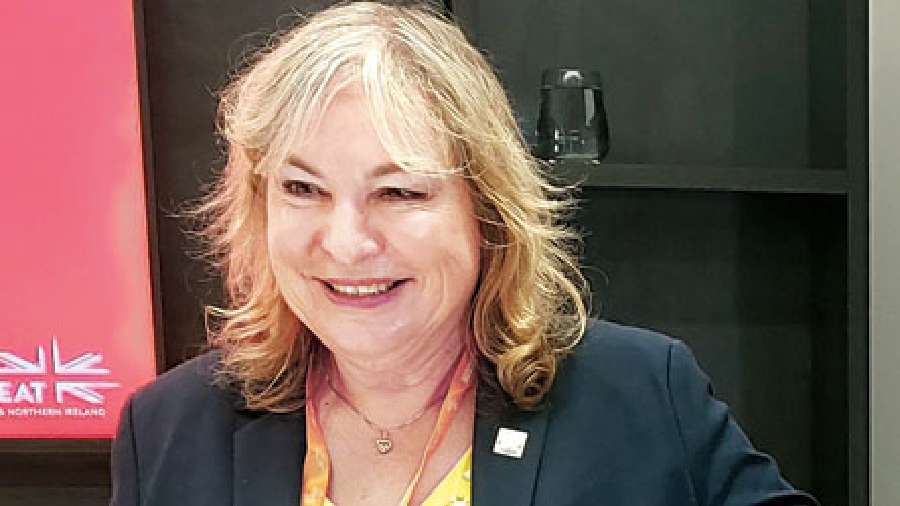
Patricia Yates
England is a favourite destination among Indians. Even then, how are you turning around from the pandemic?
All travel and tourism had stopped for a couple of years and now every destination wants to get back on the world stage.The Commonwealth Games (in 2022) gave us a real opportunity to showcase the West Midlands. Air India comes to Birmingham (from Amritsar). Before Covid, in 2019, India was worth £763 million in a year to the UK. It might be a slightly slow recovery but for India, we are looking at growth of 75 per cent by 2030, i.e. £1.3 billion. In 2020, we were down to zero. Everything was shut. Now America is fuelling our recovery, going back to 2019 levels. Europe is coming back strongly, apart from France. China was our second-most valuable market in 2019. That’s still shut. We hope to see good growth in markets like Australia and India.
At what position was the India market?
India was in the top 20. Fifty per cent of our inbound visitors never leave London. Indian tourists stay longer — the average is 16 days while for the rest of the market it is six to seven.That means they are exploring more of the country. Having a flight to Birmingham means this is where their holiday can start.We know history and heritage are our global draws but we have to tell people what the experience will be so that they can imagine themselves there and not just look at buildings.We have a great campaign that we are using in international markets.
Stratford-upon-Avon is in the West Midlands area. Is that a big draw?
Yes. Stratford with its links to Shakespeare, his birthplace — there’s the theatre there as well — and Warwick Castle next door. Authentic history has been developed as an experience and you can have a day out in a historical setting.
Other than West Midlands, which other less-frequented regions hold promise in the Indian market?
A region we are looking at is the northeast which has a world heritage site in Hadrian’s Wall. It has Alnwick Castle where the Quidditch matches were filmed on location in the first Harry Potter film (Harry Potter and the Philosopher’s Stone). Kids in Harry Potter outfts show you around.That’s different from the Harry Potter studio tour in Watford. It also has a beautiful coastline and historic cities like Durham.
Was promotion of tourism a reason behind the choice of Birmingham as the venue for the Commonwealth Games?
Birmingham was bidding for 2026 but Durban pulled out. So the city stepped up as host of the 2022 Games instead. It was a challenge for them to go four years early but that’s what they did.They got the tram system finished just before the Games.The new mayor Andy Street has big plans for the city and saw the potential to put business and tourism together.
Birmingham has a lot of Indians.Would that help pull tourists from India?
A big appetite after Covid is for visiting friends and family, and that’s really strong in the Indian market. Birmingham is wellplaced to capitalise on that with the direct flight. Also people can eat what they want to.There is a very strong Indian restaurant base.That’s true of every British city but it is especially true in Birmingham.
